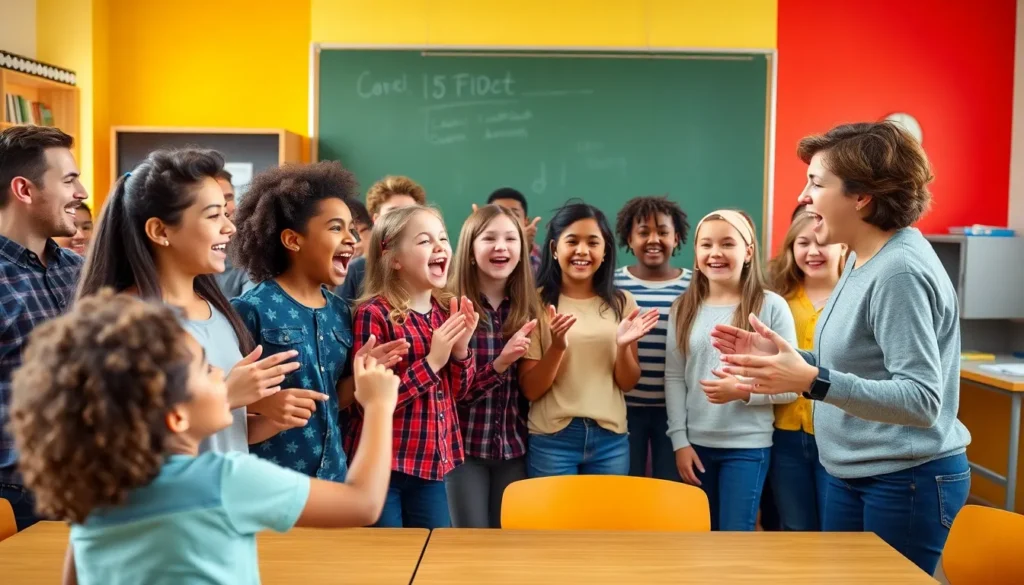Table of Contents
ToggleClassroom chants are more than just catchy phrases—they’re a secret weapon for teachers who want to boost engagement and create a lively atmosphere. Imagine a room full of students, their voices rising in unison, transforming mundane lessons into memorable experiences. It’s like a pep rally every day, minus the pom-poms and questionable snacks!
These rhythmic mantras not only help reinforce concepts but also build a sense of community among students. Who wouldn’t want to bond over a silly chant that gets everyone giggling? Plus, they’re a fantastic way to keep those little minds focused and energized. Dive into the world of classroom chants and discover how they can turn any lesson into a fun and interactive adventure that even the most reluctant learners can’t resist.
Understanding Classroom Chants
Classroom chants play a significant role in enhancing the educational experience. These rhythmic phrases engage students, enabling a lively and dynamic learning atmosphere.
Definition of Classroom Chants
Classroom chants refer to short, repetitive phrases recited by teachers and students. These chants often incorporate educational content, rhythm, and melody. They serve to reinforce specific concepts or ideas while making the learning process interactive. Educators can adapt chants to various subjects and grade levels, allowing flexibility in their usage. The simplicity of these phrases facilitates memorization, fostering retention of important information.
Purpose and Benefits
The purpose of classroom chants extends beyond mere engagement. It helps improve focus and boosts participation among students. Chants create a sense of community, encouraging collaboration and teamwork. They can also elevate energy levels, making lessons more enjoyable. Research shows that rhythmic repetition aids memory retention, increasing learning outcomes. Utilizing these chants can transform traditional teaching methods into interactive experiences, particularly benefiting reluctant learners. Embracing classroom chants cultivates a motivating atmosphere that supports overall student development.
Types of Classroom Chants
Classroom chants come in various forms, each serving distinct purposes to engage students. These types enhance the learning experience through rhythm and interaction.
Rhythmic Chants
Rhythmic chants consist of repetitive phrases set to a steady beat. Students recite these short, catchy lines during lessons to reinforce concepts. For instance, multiplication tables transform into rhythmic sequences, aiding memorization. The melody makes learning enjoyable, while the repetition strengthens retention. Educators often use these chants to break up the monotony of traditional lessons.
Call and Response Chants
Call and response chants create an interactive dynamic in the classroom. In this format, the teacher prompts a phrase or question, and students respond in unison. This interaction promotes listening skills and fosters community. An example includes a teacher saying, “What do we say when we learn?” and students responding, “We cheer and we play!” Such engagement not only reinforces learning but also boosts energy levels.
Thematic Chants
Thematic chants focus on specific subjects or themes. These chants integrate content knowledge with rhythm, aiding students in grasping complex ideas. A chant about the water cycle might include phrases like “Evaporation goes up, precipitation comes down.” Through these thematic lines, students connect learning to real-world concepts. Associative learning occurs as chants link subject matter to memorable rhythms, ensuring better understanding and recall.
How to Implement Classroom Chants
Implementing classroom chants requires thoughtful consideration and planning. Effective integration can enhance student engagement and learning.
Timing and Frequency
Timing and frequency of chants impact their effectiveness. Use chants at the beginning of lessons to energize students. Implement them during transitions to maintain focus and minimize disruptions. Incorporating chants multiple times throughout the day reinforces concepts and keeps students engaged. Educators may find success with daily routines that blend chants naturally into instruction. Research shows that regular repetition solidifies memory retention, enhancing student recall during assessments.
Tips for Effectiveness
Select chants relevant to the material being taught. Incorporate student input when creating original chants to enhance ownership and connection. Vary the tone and rhythm to keep engagement high. Ensure chants remain brief and focused to maintain students’ attention. Allow time for practice to build confidence and fluency. Use visuals or gestures alongside chants to deepen understanding. Encourage all students to participate, fostering a sense of community and collaboration.
Classroom Chants in Different Learning Environments
Classroom chants adapt well to various learning environments, enhancing engagement and collaboration.
Traditional Classrooms
Rhythmic chants thrive in traditional classrooms, energizing students during lessons. Teachers incorporate them at the start of class, capturing attention and setting a positive tone. Call and response formats promote active listening, allowing students to develop community bonds. Thematic chants reinforce subject matter like science or history, aiding comprehension. This approach fosters retention and recall, making concepts more accessible and enjoyable. Regular use of chants boosts participation while creating a lively atmosphere, essential for group cohesion.
Online Learning Platforms
Virtual classrooms utilize chants to maintain engagement and focus. In online learning environments, brief rhythmic phrases can break monotony and keep attention levels high. Specialized tools like audio and video cues help present chants effectively. Teachers can also encourage student interaction using chat features for call and response activities. Integrating thematic chants supports knowledge retention in a virtual setting, allowing students to grasp concepts effectively. Regular incorporation throughout online lessons enhances participation and enriches the overall learning experience.
Conclusion
Classroom chants are more than just fun phrases; they’re powerful tools that enhance the learning experience. By incorporating rhythmic repetition and interactive elements, educators can create a vibrant atmosphere that fosters engagement and community. The adaptability of chants across various subjects and learning environments ensures that every student can benefit, especially those who may struggle with traditional methods.
As teachers embrace this dynamic approach, they not only elevate energy levels but also improve memory retention and participation. The positive impact of classroom chants is clear, making them an essential strategy for any modern educator looking to inspire and motivate their students.








